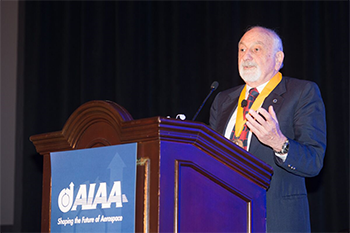Flying Safer, Flying Steadier — the Role of Active Flow Control Technology Written 11 January 2017
Speaker: Israel J. Wygnanski, professor of aerospace engineering, University of Arizona
By Duane Hyland, AIAA Communications (2008-2017)

Active flow control technology holds much promise for helping aircraft designers design safer and more efficient aircraft, Israel J. Wygnanski said Jan. 10 during the Dryden Lectureship in Research at the 2017 AIAA SciTech Forum in Grapevine, Texas.
Wygnanski's lecture, "Maturation of Active Flow Control Concepts for Improved Aircraft Performance," examined AFC technology, its uses and the results of recent experiments with the technology.
AFC technology smooths the flow of air over a plane's surface, allowing for less separation of airflow and resulting in a less turbulent, safer and more efficient flight.
Wygnanski, professor of aerospace engineering at the University of Arizona, argued that designers should use AFC technology in the design process. He walked attendees through various technical problems posed by separation of active flows of air over the wings of an aircraft. Examples include "stall, wing-tip stall and buffeting," which he said threaten an aircraft's performance.
Wygnanski shared the results of several experiments he conducted that incorporated AFC technology on aircraft. Among his findings was that by using flow actuators, or devices that extend into the flow, as small as one-eighth of an inch on the tail of a Boeing 757 aircraft, Wygnanski's team saw upwards of "15 percent gains in rudder efficiency." If the devices were part of the plane's design, he said, it would mean greater fuel savings and a safer, less turbulent flight.
The team also discovered that these actuators "lead to greater stabilization of the aircraft by keeping the flows under control," Wygnasnki said, adding that they "change the aircraft's yawing motion, resulting in steadier yaw control" with less roll.
Wygnasnki concluded that based on what he has seen in tests, the industry should integrate AFC technology into aircraft design.
"We can no longer ignore AFC," he said.
